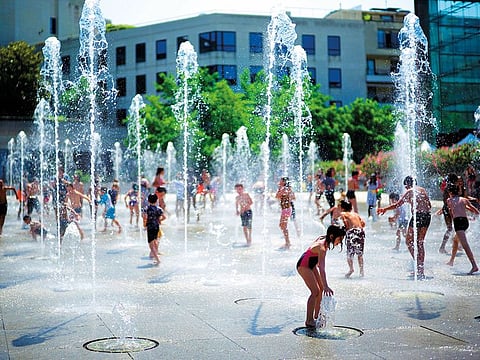Why is Europe struggling with a record heatwave?
Forest fires, school closures and frozen bananas: continent battles unprecedented weather

Also In This Package
Paris: Europe braced yesterday for the expected peak of a sweltering heatwave that has sent temperatures soaring above 40 degrees Celsius, with schools in France closing, animals surviving on ice lollies and sunscreen, and wildfires in Spain spinning out of control.
Germany imposed speed restrictions on its highways and several people were stopped by police for stripping in public. Shops in Paris ran out of fans and air conditioners, while in Rome, keepers at the city’s zoo fed animals frozen treats.
Why is there a concern about pollution?
Governments across Europe warned citizens to take extra precautions, with the high temperatures also causing a build-up of pollution, as emergency calls to hospitals increased. In most French cities, authorities banned the most-polluting cars from the roads. Scientists said global warming linked to human fossil fuel use could make such scorchers more frequent. “Global temperatures are increasing due to climate change,” said Len Shaffrey, professor of climate science at the University of Reading.
Why’s this happening now?
Weather watchers blame climate change for bringing air from the Sahara desert into Western Europe. Last year, a similar effect triggered “The Beast from the East” cold snap by allowing winds from Siberia to blow much further to the west than usual. “This increase in heat extremes is just as predicted by climate science as a consequence of global warming caused by the increasing greenhouse gases from burning coal, oil and gas,” said Stefan Rahmstorf, co-chair of Earth System Analysis at the Potsdam Institute for Climate Impact Research in Germany.
What is a heatwave?
There is no universally accepted definition of a heatwave, due to variations in climate conditions in different regions. Typically, they are defined by an unseasonably hot period - usually five degrees or more above the average daily maximum - that lasts at least three days.
What’s the scene like across Europe?
Across Europe people frolicked in fountains to stay cool while at the Bordeaux-Pessac Zoo in southwestern France, keepers handed out fish or mango ice cakes to keep the animals cool. A forest fire in Torre del Espanol in Spain’s northeastern Catalonia region raged out of control, devouring land despite the efforts of hundreds of firefighters who worked through the night. French Health Minister Agnes Buzyn said people had to be prepared for the peak of the heatwave.
What does the weekend look like for Europe?
The average maximum temperature recorded Wednesday in France of 34.9 degrees Celsius was already a record for June, said state weather forecaster Meteo France. It said France’s all-time record could be broken - an August 12, 2003 reading of 44.1 degrees Celsius in Saint-Christol-les-Ales and Conqueyrac in the southern Gard region.
Has there been a long-term impact?
Concern the heatwave would further damage Alpine glaciers that feed European rivers like the Rhine increased Wednesday as Switzerland’s meteorological agency said the 2,501-metre Saentis mountain in the eastern canton of St. Gallen recorded its highest daily minimum temperature of 16 degrees celsius.But extreme weather is also fueling long-term debates in Europe, where environmentalist parties are rising in the polls.
Why are heatwaves so dangerous?
Higher temperatures can affect anyone, but dehydration, heat exhaustion and heatstroke can have fatal consequences for people who suffer from cardiac, kidney and respiratory diseases as well as the elderly and infants. Vulnerable people may suffer particularly if overnight temperatures do not drop below 25C.
Sign up for the Daily Briefing
Get the latest news and updates straight to your inbox




